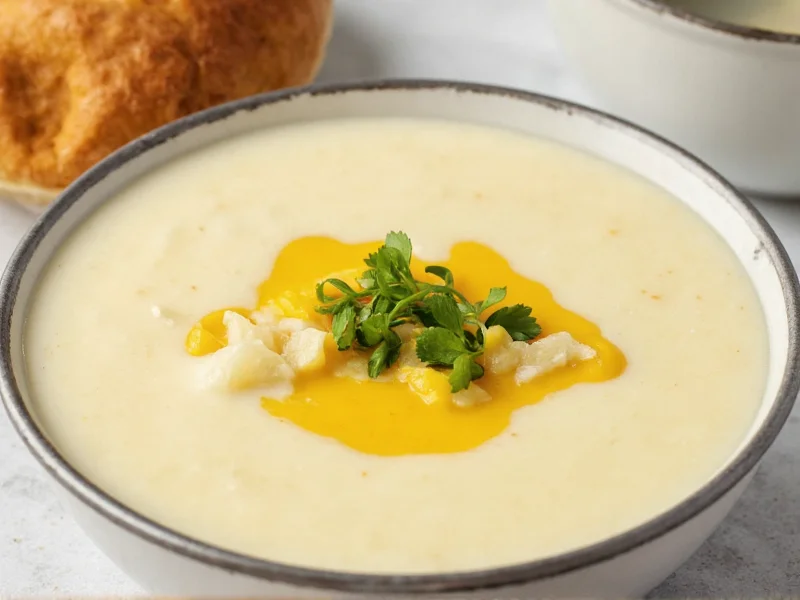Nothing beats a bowl of creamy potato soup on a chilly day. This easy homemade potato soup recipe delivers restaurant-quality results with pantry staples and minimal effort. Unlike complicated versions requiring specialty ingredients, our approach focuses on simplicity while maintaining rich flavor and velvety texture. Whether you're a beginner cook or need a reliable weeknight meal, this basic potato soup recipe for beginners works every time.
Why This Simple Potato Soup Recipe Works
Most potato soup recipes either oversimplify (resulting in bland flavor) or overcomplicate (requiring hard-to-find ingredients). Our version strikes the perfect balance by using fundamental cooking techniques that build flavor without extra steps. The secret lies in properly sautéing aromatics and controlling the simmer time to develop natural creaminess.
Ingredients for Perfect Potato Soup
Makes 4 servings | Total time: 30 minutes
| Ingredient | Amount | Notes |
|---|---|---|
| Russet potatoes | 2 pounds (about 4 medium) | Peeled and 1/2-inch diced for even cooking |
| Yellow onion | 1 medium, finely chopped | Yellow provides best flavor foundation |
| Garlic cloves | 2, minced | Fresh preferred over powder |
| Unsalted butter | 2 tablespoons | For sautéing aromatics |
| Chicken or vegetable broth | 4 cups | Low-sodium preferred |
| Whole milk | 1/2 cup | Creates creaminess without heavy cream |
| Salt and pepper | To taste | Start with 1 tsp salt, 1/4 tsp pepper |
Step-by-Step Instructions
- Prepare potatoes: Peel and dice potatoes into uniform 1/2-inch cubes. Rinse under cold water to remove excess starch.
- Saute aromatics: Melt butter in a large pot over medium heat. Add onion and cook until translucent (5 minutes). Stir in garlic and cook 1 minute until fragrant.
- Add liquids and potatoes: Pour in broth and add diced potatoes. Bring to a gentle boil, then reduce heat to low.
- Simmer until tender: Cover and simmer 15-18 minutes, or until potatoes pierce easily with a fork. Do not overcook.
- Blend until smooth: Using an immersion blender, puree soup directly in the pot until smooth. Alternatively, carefully transfer to a countertop blender in batches.
- Add finishing touches: Stir in milk, salt, and pepper. Heat gently (do not boil) for 3-5 minutes to allow flavors to meld.
- Serve immediately: Ladle into bowls and garnish with fresh chives or a sprinkle of paprika.
Pro Tips for the Best Potato Soup
- Potato selection matters: Russets work best for creamy texture due to their high starch content. Avoid waxy potatoes like reds which won't puree smoothly.
- Don't skip the sauté step: Cooking onions and garlic in butter before adding liquids develops essential flavor compounds.
- Control the thickness: Add extra broth 1/4 cup at a time if soup becomes too thick during simmering.
- Avoid curdling: Never boil after adding dairy. Keep heat at low simmer to maintain smooth texture.
Simple Variations to Try
This quick creamy potato soup base adapts beautifully to different preferences:
- Vegetarian version: Use vegetable broth instead of chicken broth
- Extra hearty: Add 1/2 cup diced cooked bacon with the aromatics
- Lighter option: Substitute milk with unsweetened almond milk for healthy potato soup without cream
- Flavor boost: Stir in 1/4 teaspoon smoked paprika or dried thyme during simmering
Storage and Reheating Instructions
Store cooled soup in an airtight container in the refrigerator for up to 4 days. For longer storage, freeze portions in freezer-safe containers for up to 3 months. When reheating:
- Thaw frozen soup overnight in the refrigerator
- Reheat gently on stove over medium-low heat, stirring frequently
- Add 1-2 tablespoons of broth or milk if soup has thickened during storage
- Never microwave frozen soup containers
Frequently Asked Questions
Can I make this simple potato soup recipe without dairy?
Yes, you can easily create a dairy-free version of this simple potato soup with few ingredients. Substitute the milk with unsweetened almond milk or coconut milk, and use olive oil instead of butter for sautéing. The potatoes themselves create natural creaminess when properly blended, so you'll still achieve a smooth texture without dairy products.
Why did my potato soup turn out grainy?
Grainy texture usually happens when potatoes are overcooked or when using the wrong potato variety. Russet potatoes should be simmered just until fork-tender (15-18 minutes), not until they're falling apart. Waxy potato varieties like red potatoes contain less starch and won't puree smoothly. For the creamiest results with this easy homemade potato soup recipe, stick to russets and monitor cooking time carefully.
How can I make potato soup thicker without adding flour?
The simplest method is to reserve 1 cup of cooked potatoes before blending, then mash them separately and stir back into the soup. Alternatively, simmer uncovered for 5-10 minutes to reduce liquid content. For this weeknight potato soup recipe, you can also add 1/4 cup instant potato flakes which absorb liquid while enhancing potato flavor without altering taste.
Can I use leftover mashed potatoes in this recipe?
Absolutely! This is a great way to repurpose leftovers. For every 2 cups of mashed potatoes, use 3 cups of broth. Skip the raw potato step and begin by sautéing aromatics, then whisk in mashed potatoes with broth. This shortcut version of our basic potato soup recipe for beginners reduces cooking time to just 15 minutes while maintaining excellent flavor and texture.











 浙公网安备
33010002000092号
浙公网安备
33010002000092号 浙B2-20120091-4
浙B2-20120091-4